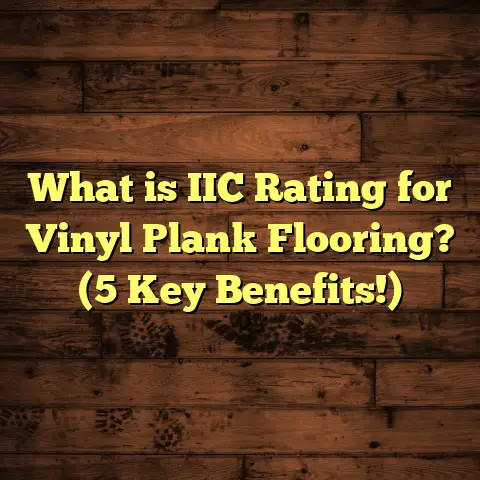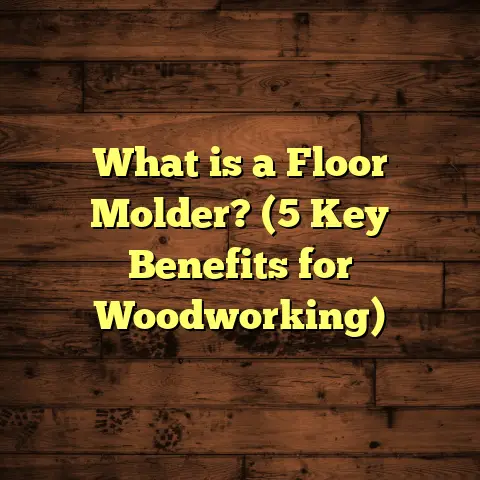What is a Structural Floor Slab? (5 Key Benefits Explained)
Bold designs in architecture often start from the ground up—literally. When I think about some of the most striking buildings I’ve worked on or admired, their foundation plays a huge role in supporting those daring ideas. That foundation? Often it’s a structural floor slab. This seemingly simple element can be the unsung hero that holds everything together while offering incredible benefits beyond just support.
What is a Structural Floor Slab?
So, what exactly is a structural floor slab? Simply put, it’s a thick, flat piece of concrete or sometimes other materials, designed to serve as a main horizontal support system in a building. It’s not just any floor; it’s the heavy-duty base that carries loads from above and transfers them safely down to the foundation and soil beneath.
In construction, slabs act like giant plates—distributing weight evenly across an area, preventing uneven settling or cracking. They can be found in various forms: ground slabs sitting directly on soil, suspended slabs spanning between beams or walls, and post-tensioned slabs which use tensioned steel cables inside the concrete for extra strength.
I remember working on a project where the design called for an open-concept living space with no columns interrupting the floor area. The solution was a post-tensioned structural slab that spanned great distances, allowing for that vast, uninterrupted space. That’s just one example of how slabs enable bold architectural choices.
But beyond just what they are, structural floor slabs come loaded with benefits that make them a favorite choice for many builders, architects, and homeowners alike. Let me walk you through five key advantages I have seen repeatedly on the job.
1. Exceptional Load-Bearing Capacity
One of the biggest benefits I’ve seen firsthand is how structural slabs can carry massive loads without bending or breaking. Unlike wooden joists or other floor systems, concrete slabs can support heavy equipment, furniture, and even vehicles in garages or industrial settings.
Understanding Load-Bearing
When we talk about load-bearing capacity, we’re referring to how much weight a floor can safely hold without failing. Think about the different types of loads:
- Dead loads: These are permanent forces like the weight of the slab itself, walls, and fixtures.
- Live loads: Temporary or movable weights like people, furniture, or snow on a roof.
- Impact loads: Sudden forces such as dropping something heavy.
Concrete slabs are excellent at managing all these because of the material properties and reinforcement methods used.
Concrete Strength and Reinforcement
Concrete itself is strong in compression but weak in tension (pulling forces). To overcome this, steel reinforcement bars (rebar) or mesh are embedded inside the slab. This combination provides tensile strength and prevents cracking or failure under stress.
According to the American Concrete Institute (ACI), typical reinforced concrete slabs have compressive strengths ranging from 3,000 to 7,000 psi (pounds per square inch). For context, structural steel has tensile strengths around 36,000 to 58,000 psi, but when combined with concrete in slabs, you get a composite system well-suited for various loads.
Real-World Example
I was involved in constructing a multi-story parking garage where the slabs had to support not only the weight of vehicles but also dynamic loads from moving cars. The engineering team designed the slabs at 8 inches thick with high-strength reinforcement patterns. During testing phases, we simulated heavy loads with forklifts and trucks, and the slabs performed flawlessly.
The lesson? A well-designed structural slab offers peace of mind in load handling that other floor systems struggle to match.
2. Durability and Longevity
Durability is something I always emphasize with clients. Floors take a beating—whether it’s foot traffic, dropped tools, spills, or weather exposure. Structural floor slabs stand out because they resist wear and tear better than most alternatives.
Why Concrete Lasts
Concrete is naturally resistant to many factors that degrade other materials:
- Moisture Resistance: Unlike wood floors which rot or warp when wet, concrete handles moisture without significant damage.
- Pest Resistance: Termites and other pests don’t bother concrete.
- Fire Resistance: Concrete doesn’t burn or release toxic fumes.
- Impact Resistance: Heavy drops or impacts cause less damage compared to hardwood or laminate.
Data on Lifespan
Industry data suggests that concrete floors can last 50 years or more with minimal maintenance. In fact, I’ve seen slabs in century-old buildings still functioning structurally sound beneath modern finishes.
For example, a study by the Portland Cement Association points out that many concrete floors installed in warehouses and industrial plants in the mid-20th century are still operational today.
My Experience with Durability
On a recent project renovating an old warehouse into office spaces, we inspected the original concrete slabs. Some areas had minor cracks from decades of use but overall remained intact structurally. Repairing cracks and polishing the surface gave it new life—a cost-effective alternative to full replacement.
This durability factor means fewer repairs over time and less hassle for building owners.
3. Energy Efficiency through Thermal Mass
Here’s something that may come as a surprise: structural floor slabs contribute significantly to energy efficiency thanks to thermal mass.
What Is Thermal Mass?
Thermal mass refers to a material’s ability to absorb, store, and release heat slowly. Materials with high thermal mass moderate indoor temperature swings by soaking up heat during the day and releasing it at night.
Concrete is perfect for this because it has a high density and specific heat capacity.
How This Benefits Buildings
In climates with large temperature fluctuations between day and night, thermal mass helps:
- Reduce heating costs in cold nights by releasing stored warmth.
- Lower cooling costs during hot days by absorbing excess heat.
Radiant Floor Heating
I’ve worked on homes where radiant heating systems were embedded inside structural concrete slabs. This combination is fantastic because:
- The slab evenly distributes heat across the floor surface.
- It holds warmth longer than traditional forced-air systems.
- It reduces dust circulation since it doesn’t rely on air movement.
According to research by the U.S. Department of Energy, radiant heated concrete floors can reduce energy consumption for heating by 10-20%.
Personal Anecdote
One winter, I stayed overnight in a house with radiant heated slabs. The warmth was steady and cozy without hot spots or drafts common in homes with vents. It felt natural and comfortable—proof that slabs can enhance living quality beyond basic structure.
4. Design Flexibility and Aesthetics
Structural floor slabs aren’t just functional; they offer incredible design freedom.
Open Floor Plans Without Columns
Because slabs distribute weight evenly over wide areas, architects can create open spaces without many supporting columns. This ability is crucial for modern layouts emphasizing fluidity and openness.
I recall working on a commercial gallery where the slab allowed for an uninterrupted display area—perfect for large art installations without visual breaks from columns.
Variety of Finishes
Slabs can be transformed visually through several finishes:
- Polished Concrete: High-gloss surface that reflects light beautifully.
- Stained Concrete: Adds color variations for artistic effects.
- Stamped Concrete: Mimics stone, tile patterns, or even wood grain textures.
- Bare Industrial Look: For lofts and modern designs emphasizing raw materials.
Each finish comes with maintenance levels and cost implications—something I always discuss with clients upfront.
| Finish Type | Appearance | Maintenance | Cost Impact |
|---|---|---|---|
| Polished Concrete | Smooth, glossy | Low | Moderate |
| Stained Concrete | Colored variations | Low | Moderate |
| Stamped Concrete | Patterned textures | Medium | Higher |
| Bare Concrete | Raw industrial look | Low | Low |
Polished concrete has become increasingly popular due to its sleek look combined with durability. It’s common in retail stores, offices, and modern homes.
Custom Embeds and Inserts
Another design flexibility point I love is embedding materials like glass chips, metal flakes, or even fossils into freshly poured slabs for unique effects.
One project involved embedding decorative stones into the slab for an outdoor patio area—it created an elegant yet rugged surface that felt connected to nature.
5. Faster Installation and Cost Savings
Let’s talk money and timelines—two things everyone cares about when building or renovating.
Efficient Installation Process
Structural floor slabs poured directly on grade eliminate the need for complex framing systems like joists or beams beneath floors. This simplifies construction steps:
- Less framing labor.
- Fewer materials like lumber.
- Reduced site preparation time once subgrade is ready.
For suspended slabs (above ground), prefabricated formwork systems speed up pouring and curing cycles too.
Cost Comparison
From budgets I’ve worked with and industry averages:
- Installing concrete slab floors can save 15-25% compared to traditional wood-framed floors.
- Over time, lower maintenance costs improve total cost of ownership.
- Longer lifespan means less frequent replacement expenses.
An example from one project showed that switching from wood joist flooring to post-tensioned slab reduced overall construction duration by two weeks—saving on labor costs and accelerating occupancy.
Waste Reduction
Using slabs also reduces material waste compared to framing systems where offcuts and scrap wood add up quickly. Plus, proper slab design incorporates waste factors upfront—helping avoid over-ordering materials.
Diving Deeper: Types of Structural Floor Slabs
Understanding different types of slabs helps clarify their uses and benefits. Let me break down some common categories based on construction methods:
Ground-Supported Slabs (Slab-on-Grade)
These slabs are poured directly on compacted soil or gravel bases. They’re common in single-story homes or buildings without basements.
Advantages:
- Simple design.
- Lower cost.
- Good thermal mass effects due to ground contact.
Challenges:
- Requires proper soil preparation to avoid settling.
- Moisture barriers needed to prevent dampness rising into slab.
I’ve worked on many residential projects using slab-on-grade foundations because they’re cost-effective and quick to build when site conditions are favorable.
Suspended Slabs
These slabs are supported by beams or walls below rather than sitting on soil. Found in multi-story buildings or where basements exist.
Advantages:
- Allows construction above uneven terrain.
- Separates living spaces from ground moisture.
These require more complex engineering due to load distribution needs but provide flexibility for multi-level architecture.
Post-Tensioned Slabs
Post-tensioning involves placing steel cables within the concrete slab which are tightened after pouring to add compressive force—improving strength and reducing slab thickness.
Benefits:
- Longer spans without support columns.
- Reduced cracking risks.
I’ve seen these used in large commercial spaces where column-free areas were critical. Though pricier upfront, they save space and provide design options impossible otherwise.
Real-Life Case Studies Showing Structural Floor Slab Benefits
To make this less abstract, here are a few case studies from my experience illustrating why slabs matter:
Case Study 1: Community Recreation Center
Project: A large community center with multi-use halls requiring open space and heavy equipment storage underneath stages.
Challenge: Support heavy loads without columns obstructing space.
Solution: Post-tensioned slab spanning 40 feet between supports at only 8 inches thick.
Result: The slab passed rigorous load testing including live events with crowds and equipment moved frequently. The client loved how open the hall felt—perfect for concerts and sports alike.
Case Study 2: Residential Home Renovation
Project: A 1950s house needed floor repairs due to uneven settling causing cracks in wood floorboards above a failing slab-on-grade foundation.
Approach: We used ground-penetrating radar to identify weak zones in the existing slab non-destructively. Targeted epoxy injection repairs stabilized the slab beneath without removing entire floors.
Outcome: Homeowners saved thousands compared to full slab replacement while restoring stable flooring surfaces quickly.
Case Study 3: Industrial Warehouse Flooring
Project: A distribution center required floors able to withstand forklift traffic and pallet stacking without damage over decades.
Execution: Thick reinforced concrete slabs with hard-wearing surface treatments were installed using fast-set mixes for quick turnarounds between pours.
Performance: Floors showed minimal wear after five years despite high daily traffic volume—a testament to durability inherent in well-designed structural slabs.
Maintenance Tips for Structural Floor Slabs
Even though slabs are tough, some care extends their life further:
- Seal Concrete Surfaces: Applying sealers prevents moisture ingress and staining.
- Control Cracks Early: Small hairline cracks are normal but should be sealed promptly.
- Avoid Harsh Chemicals: Deicing salts or acids can degrade surfaces over time.
- Regular Cleaning: Sweeping or washing prevents buildup of abrasive dirt particles.
In my projects, I recommend sealing polished concrete floors every few years depending on traffic levels. Simple upkeep keeps floors looking fresh and performing well long-term.
Common Questions About Structural Floor Slabs
I often get asked these questions by clients new to slabs:
How thick should my structural floor slab be?
Thickness depends on building type and load requirements but typically ranges from 4 inches for residential slabs-on-grade up to 12 inches or more for heavy industrial uses.
Can I install hardwood flooring over a concrete slab?
Yes! But you’ll need a moisture barrier and possibly underlayment to prevent moisture damage and ensure comfort underfoot.
Do structural slabs crack easily?
Slabs do develop cracks due to shrinkage as concrete cures or slight movement in soil but proper reinforcement minimizes serious cracking. Control joints also help manage cracks predictably.
How long does it take for a slab to cure?
Standard curing takes about 28 days for full strength development but floors can be walked on within days depending on mix design and conditions.
Final Thoughts on Structural Floor Slabs
When I reflect on all my years working with structural floor slabs—from residential homes to expansive commercial buildings—I realize just how vital they are beyond what meets the eye.
They’re not just flat surfaces where you place furniture—they’re engineered systems balancing strength, durability, energy efficiency, design flexibility, and cost-effectiveness. They enable architects and builders like me to push boundaries in design while delivering reliable performance for decades.
If you’re weighing flooring options or planning construction projects that require strong foundations with versatility, consider giving structural floor slabs serious thought. Their benefits often surprise people once they understand what goes into their design and performance capabilities—just like they surprised me early in my career when I saw how much they could do beyond supporting weight alone!
Got questions? Need advice tailored for your project? I’m here to help you figure out if a structural floor slab is right for you—and how best to implement one so your bold design ideas stand firm from day one onward.





